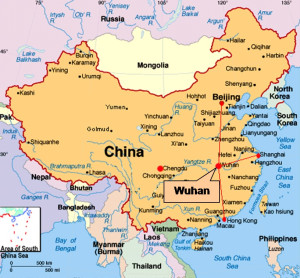Wuhan: Who’s Been Impacted?
Article By : Clover Lee

The lockdown in Wuhan is affecting a whole host of local high-tech companies. They range from manufacturers of display panels, memory, fiber optics, auto parts to suppliers of components, bio-medicine and medical devices. Here’s who’s who.
[Editor’s note: During the Wuhan lockdown, the General Office of the State Council issued notices to extend the 2020 Spring Festival holiday by a week.
Most provinces and municipalities in China followed that notice and told businesses not to resume work before Feb. 10 at the earliest.
The Hubei Provincial Government stipulated that various enterprises in the province will resume work no earlier than 24:00 on Feb. 13.
In the context of the Wuhan lockdown and the delay in resumption of business, what’s happening to the companies in Hubei Province? And how will that affect the supply chain inside and outside China? Here’s what our editorial team at ESM China, EE Times’ sister publication, has found out thus far.]

At present, Wuhan, along with most cities within Hubei province, is in a state of lockdown. Obviously, the industries — ranging from transportation to catering and tourism within the province — are significantly affected.
The lockdown is hitting key industrial sectors. According to our database, Wuhan excels in three sectors — telecommunications, automotive, and pharmaceutical. The city also has three world-class industrial clusters. They include making display panels and memory/optical communications; automobiles and parts/components; and biomedicine and medical devices. The region has four national industrial bases or centers of expertise: storage, cybersecurity, EVs/connected cars and aerospace.

Wuhan, the capital of Hubei, is the composite name of the three former cities (and now districts) of Hankou, Hanyang, and Wuchang. The city is located at the confluence of the Han River and the Yangtze River. It is 600 miles from the sea, and halfway between Shanghai and Chongqing.
Its geographical location makes Wuhan a transportation hub in China. But the region is also a hub for many corporations. The province lists as many as 106 companies, 60 of them in Wuhan. Others are based elsewhere in Hubei province.
Look closely: Hubei Province has more than 20 companies in the electronic communications industry, 11 in pharmaceuticals, and four in automotive. The outbreak of coronavirus has prompted related enterprises in Hubei province to suspend production and postpone resumption of work. This is likely to have a ripple effect throughout China.
Who’s who in Wuhan
Our database shows about 20 industrial-chain companies listed in Hubei.
They include Wingtech, San’an Optoelectronics, Techsem, Yingtong Telecommunication, FiberHome Telecommunication, and Wuhan Fingu. These companies are involved in semiconductor components, semiconductor equipment, RF front ends, optical modules, optical communication equipment, and LEDs, among others.
Below, we created a table for “Who’s Who” in Wuhan. While the list is not meant to be exhaustive, we believe this gives a good snapshot of which high-tech companies are located in the region.
| FiberHome Telecommunication
Technologies Co., Ltd. |
http://www.fiberhome.com/en/default.aspx | The company is a globally renowned information and communication network product and solution provider |
| Wuhan Yangtze Communications
Industry Group Co., Ltd. (YCIG) |
http://en.ycig.com/index.html | YCIG is one of the backbone enterprises of Wuhan Optics Valley. YCIG is mainly engaged in investment, R&D, and production of communications products, including optical transmission equipment, access network equipment, optical fiber and cable, wireless communications systems and equipment, base station radiofrequency cables, digital video equipment, and others. |
| Wuhan Raycus Fiber Laser
Technologies Co., Ltd. |
http://en.raycuslaser.com | Wuhan Raycus is the first Chinese enterprise engaged in the research, development, and scale production of high-power fiber lasers and core devices. |
| Yangtze Optical Fibre and
Cable Joint Stock Limited Company (YOFC) |
https://en.yofc.com | YOFC mainly produces and sells a variety of optical fiber preforms, optical fibers, and optical fiber cables, which are broadly installed in the telecommunications industry. YOFC also makes customized specialty optical fibers and optical fiber cables, RF coaxial cables, and accessories. |
| Wuhan Ligong Guangke Co.Ltd. | http://www.wutos.com | The company has core intellectual property rights in sensitive fiber optic materials. It offers key core devices, intelligent instruments, and advanced sensing systems. The company has formed a series of fiber optic sensing detection systems and IoT application solutions. |
| Wuhan Guide Infrared Co., Ltd. | http://www.guideinfrared.com/index/index.html | The company uses infrared (IR) thermal imaging technology to offer a complete infrared industrial chain, ranging from core component-IR detectors to integrated optoelectronic systems. |
| Hubei Jiuzhiyang Infrared System Co., Ltd. | http://english.hbjir.com | The company is engaged in the research, production, and marketing of infrared thermal imagers and laser range finders. |
| Huagong Tech Company Limited | http://en.hgtech.com.cn | Huagong Tech was the first laser-based high-tech company to go public in China. The company pools resources to develop intelligent manufacturing solutions by leveraging laser equipment technologies, optical communication devices, laser holographic anti-counterfeiting, sensors, and information tracing. |
| Wuhan DR Laser Technology Co., Ltd | http://www.drlaser.com.cn/eng/ | DR laser is specialized in R&D and production and sales of laser equipment. Its products mainly include laser-cutting machinery, laser ablation, PERC battery, etc. |
| Wuhan Golden Laser Co., Ltd. | https://www.goldenlaser.cc | Golden Laser focuses on providing intelligent, digital, and automated laser solutions. It manufactures laser systems for cutting, engraving, and marking. The company is a specialist in CO2 laser-cutting machinery and Galvo laser machines. |
| Accelink Technologies Co., Ltd. | http://en.accelink.com | Accelink is a leading manufacturer of optoelectronic devices in optical communications. It’s engaged in R&D for key technologies of optoelectronic chips and their mass production. |
| Wuhan Jingce Electronic Group Co,Ltd | http://www.wuhanjingce.com/index.html | The company is dedicated to providing products and services for semiconductor, display, new energy, and other testing fields. |
| Wuhan Fingu Electronic Technology Co., Ltd. | http://www.fingu.com/en_index.aspx | The company offers a variety of solutions ranging from traditional RF devices to 4.5/5G. Their products include: filter, duplexer; combiner, tower-mounted amplifier (TMA); ceramic material; POI; microwave antenna, radio, and other components. |
| Hubei DingLong Co., Ltd. | http://en.dl-kg.com | The company offers color chemical polymerized toner(CPT) in charge control agents (CCA), colorants, and special pigments for both imaging industry and automotive producers. |
| Wuhan P&S Information Technology Co., Ltd. | http://www.icbase.com/psen/ | P&S is an electronic component service provider well known in China. The company offers more than 10 product categories, including the microcontrollers, system management devices, communication interface devices, data converters and signal-conditioning devices, power management devices, memory, connectors, discrete semiconductors and passive devices, and others. |
| Wuhan HC SemiTek Co., Ltd. | http://www.hcsemitek.com/en | HC SemiTek is the second-largest supplier of LED chips in China and the leading supplier of LED chips for display screens in China. In 2015, it acquired Crystaland Co., Ltd. to integrate the upstream industry resources of LEDs. In 2018, it acquired MEMSIC to form the dual main industry development of LED chips and MEMS sensors in the future. |
| Yangtze Memory
Technologies Co., Ltd. (YMTC) |
http://www.ymtc.com/ | The company is focused on design and manufacturing of 3D NAND flash memory. |
| Wuhan Xinxin Semiconductor
Manufacturing Co., Ltd. (XMC) |
http://www.xmcwh.com/ | The company is focused on R&D and manufacturing of NOR flash. |
| Wuhan Hongxin Semiconductor
Manufacturing Co., Ltd. (HSMC) |
http://en.hsmc.com/ | Founded in November 2017, HSMC is engaged in manufacturing services of wafers with advanced logic technology up to 14–7 nm. The construction of the first phase of the plant is under way. |
| Wingtech Technology Co., Ltd. | http://www.wingtech.com/en | Wingtech’s main business includes communication terminal and semiconductor business. Wingtech is an integrated device manufacturer In 2018, the company acquired Dutch semiconductor firm Nexperia, formerly the Standard Products business unit of NXP Semiconductors. Nexperia manufactures bipolar transistors, diodes, ESD protection, TVS diodes, MOSFETs, and logic devices. |
| San’an Optoelectronics Co., Ltd. | http://www.sanan-e.com/en/ | The company is engaged in the research and development and application of epitaxial wafers and chips related to new compound semiconductor materials such as gallium arsenide, gallium nitride, silicon carbide, indium phosphide, aluminum nitride, and sapphire. |
| Wuhan China Star Optoelectronics
Semiconductor Display Technology Co., Ltd. (CSOT) |
http://www.szcsot.com/?2 | The company produces small and medium-sized displays. One of CSOT’s plants, known as T3 and based in Wuhan, is the largest low-temperature polycrystalline silicon (LTPS) plant in the world. CSOT’s other plant, known as T4, produces flexible AMOLEDs in Wuhan. |
| Wuhan BOE Optoelectronics Technology Co., Ltd. (BOE) | https://www.boe.com/en/ | BOE is one of the world’s largest manufacturers of LCDs, OLEDs, and flexible displays. BOE has a 10.5-generation TFT-LCD production line in Wuhan, designed to produce 65- and 75-inch high-resolution LCD panels for TV manufacturers. |
| Corning Display Technologies (Wuhan) Co., Ltd. | https://www.corning.com | Corning invested $1.4 billion to build a new production facility in Wuhan in order to supply specialty glass for new factory complexes operated by BOE. Corning’s glass substrate project went into production in 2019. |
| Tianma Microelectronics Co., Ltd | http://en.tianma.com/index.shtml | The company manufacturers display units, with a strong presence in in the small and medium size displays. In Wuhan, Tianma has TM8 Gen 4.5 Low-temperature polycrystalline silicon (LTPS) LCD fab, in addition to TM17 Gen 6 OLED fab. |
| TKD Science and Technology Co., Ltd. (TKD) | http://www.sztkd.com | TKD, China’s leading player in the quartz crystal industry, makes and exports the quartz frequency control components. |
| Thalys Medical Technology Co., Ltd. | https://www.thalys.net.cn/en | Thalys is a company focused on medical integrated business and operation services. |
| Wuhan Easy Diagnosis Biomedicine Co., Ltd, | http://www.mdeasydiagnosis.com/en/ | The company is a leading in vitro diagnostic (IVD) manufacturer, specialized in development, production and sales of point-of-care testing (POCT) rapid diagnostic reagents and related equipment. |
| China Bester Group Telecom Co., Ltd. | http://www.whbester.com/?lang=en | The company’s business is in communication network construction. It also offers integration of communication and information systems, optimization and maintenance of communication networks, and communication network planning and design. |
Industry chain companies are facing challenges
Products made by companies in Hubei will affect both the upstream and downstream supply chains of each industrial sector. This is partly because some companies are operating on a different schedule for restart.
Industrial chain companies, even if their factories return to function, could face unavoidable challenges. Beyond their control are logistics and transportation, as well as the absence of employees who went away for the holiday and can’t get back. Shortages of materials are also a concern.
Moreover, since the coronavirus outbreak, companies must pay closer attention to their employees’ health.
For example, if one employee is diagnosed with a confirmed case of coronavirus, protocol requires either shutdown or isolation of the entire plant. In this light, employee health becomes an issue that could easily affect the entire supply chain.
Industry insiders in China laid out the most optimistic scenario:
The epidemic situation will be completely lifted by mid- to late March, and the industrial chain will gradually return to normal supply in April. By that time, the market demand will pick up and the capacity of the industry chain will catch up quickly.
How are they coping with lockdown?
We reached out to several companies to see how they are coping with the lockdown. Most downplayed the impact of the epidemic. Some explained that, although they might be registered in Hubei, their operations are scattered throughout China or even overseas.
- Wingtech: Saved by dispersal
Although the original registered address of Wingtech is Huangshi City, Hubei Province, its main factories are scattered overseas and in other cities in China. The company explained, therefore, that Hubei’s closure has not impacted its business.
Wingtech’s overseas factories reportedly did not stop during Lunar New Year. Domestic factories were originally expected to resume work at the end of January. Among them, a factory in Jiaxing was scheduled to resume work on Jan. 30 and a Wuxi factory re-opened on Jan. 31. At present, the company’s R&D and production are operating normally.
- San’an Optoelectronics: Factories elsewhere
San’an Optoelectronics is mainly engaged in research and development and application of epitaxial wafers and chips related to new compound semiconductor materials such as gallium arsenide, gallium nitride, silicon carbide, indium phosphide, aluminum nitride, and sapphire.
San’an’s factories are concentrated in Xiamen and Quanzhou. A new factory in Ezhou, Hubei province is under construction. With no production in Hubei, the epidemic’s impact on San’an Optoelectronics is minimal.
- Wuhan Fingu: Ready for a rainy day
On Feb. 3, Wuhan Fingu claimed that it is weathering the epidemic because of its Spring Festival contingency plan, stocking up inventory reserves for production delivery during and after the holiday. During the Spring Festival, a small number of employees worked overtime to handle delivery of urgent orders. Currently, domestic cargo logistics and transportation and highway channels are unblocked, leaving the company unfazed by the virus.
- CSOT: A short-term lag
TCL Group announced that China Star Optoelectronics Technology (CSOT) has two plants in Wuhan to produce small and medium-sized displays. The epidemic is causing short-term delays in supplying some production materials. The company, however, is doing workarounds with key suppliers to coordinate the logistics that will get the materials it needs. This will require “adjustments” in production and operation strategies.
- BOE: Wuhan production wasn’t ready anyhow
BOE has a 10.5-generation TFT-LCD production line in Wuhan, designed to produces 65- and 75-inch high-resolution LCD panels for TV manufacturers. However, the line has yet to reach its mass-production phase. So any downstream impact is limited.
- Corning: Factories to spare
Corning’s glass substrate project went into production in 2019. It already has three factories in Beijing, Chongqing, and Hefei in China. Its downstream impact should be confined to Hubei’s internal panel factory.
- Yangtze Memory Technologies Co., Ltd. (YMTC) and XMC: All is good
Reportedly, the 3D NAND chips of YMTC and the NOR flash and CIS chips produced by XMC have shipped normally through special channels. The two companies also reported no current shutdown or logistics delays.
However, further spread of the epidemic could pose challenges.
- HSMC: No machines, no shipments
Wuhan Hongxin Semiconductor Manufacturing Co., Ltd. (HSMC) said it is waiting for new machines. If the epidemic delays delivery of the equipment, R&D and production will feel the impact.
It is expected that during Q1–Q2 of 2020, HSMC machine equipment will enter a “peak period.” New equipment already installed consists mainly of lithography machines. More equipment is scheduled to be in place after March.
- TKD Science and Technology: Disinfected
On Jan. 31, TKD announced its subsidiary TKD Crystal’s early return to work, as it received an urgent order for epidemic prevention and control supplies from an important medical device company. The company immediately contacted the Suizhou Public Security Bureau. After obtaining permission, the inside and outside of the TKD Crystal plant were disinfected and the company undertook protective measures.
The company completed the work of source allocation, capacity adjustment, warehouse delivery, and delivery of its products within three hours. In the afternoon of the same day, all goods were loaded by 5 p.m. and delivered on time at 9 p.m. TKD has promised to maintain production while the epidemic rages.
Subscribe to Newsletter
Test Qr code text s ss


